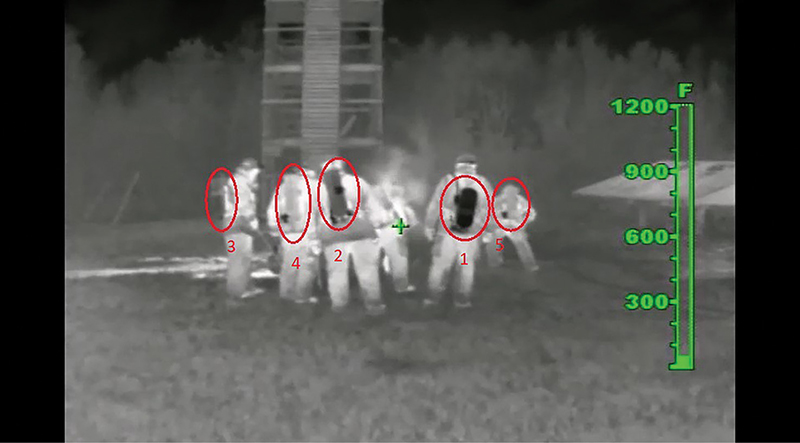A rapid intervention crew or team (RIC/RIT)—two or more firefighters designated to perform firefighter rescue—is stationed outside the hazard and must be standing by throughout the incident.

The development, planning, training, and standby use of RICs has increased in recent years. Proper RIC planning and training includes determining what tools should be available to the RIC besides communications, air, extrication, lighting, and an obvious one being my opinion that the most important tool is the thermal imager (TI).
Key considerations for TI use during RIC deployment follow:
- Determine who will carry the TI and use it. While the most likely scenario is having the RIC officer use the TI, it is important to train within your RIC system to ensure that this approach is feasible and is the best option for your department.
- As with civilian search efforts, firefighters must look for key shapes to help them identify humans. For the RIC seeking a missing firefighter, three of the most likely visual identifiers are the self-contained breathing apparatus (SCBA) cylinder and face piece and the fire helmet.
- If the firefighter in need is completely covered by debris, the TI will probably not be as effective at locating him. The RIC will have to use traditional search techniques, possibly moving debris prior to searching an area. The TI will, however, still be helpful to the RIC in guiding its members more safely through the structure and helping them identify debris piles that require additional investigation.
- Protective clothing can absorb significantly more heat than civilian clothing, so the relative temperature of the firefighter in need could be much higher than temperatures normally encountered with civilian victims. A firefighter could appear as white or light gray on the TI display.
- TIs only return a semblance of sight to the RIC. There are limitations to a TI, so a firefighter in need still must rely on the basics for guiding the RIC to his position: give a “Mayday” on the radio with his location and situation, activate his PASS, make noise with a tool, and activate any hand lights available.
- To see if the firefighter is still breathing, check the SCBA tank and regulator for color. If black or dark, there is still air flowing;, if opposite in color, this is not a good indicator.
PRACTICE MAKES PERFECT
The TI can be an important tool for RIC operations. As I have emphasized before, proficiency demands regular use, and regular practice can help firefighters avoid overreliance. As with any other TI drill, it is important that firefighters know how to perform their required tasks with and without the aid of a TI to ensure solid skills. It is also important to conduct drills where the TI is “lost” at some point, verifying that firefighters can continue with their assignment even if they lose the TI.

1 Five SCBA cylinders indicating different colors based on duration of use. (Photo courtesy of Bullard.)
During RIC drills, firefighters should train to look for key visual indicators of a down firefighter. By dressing a rescue dummy in firefighting gear or by having a firefighter wear his gear during the drill, TI users can practice looking for unique shapes. As with other searches, remember that shape is usually more important than the shade of gray seen on the TI’s display. The SCBA tank and face piece and the fire helmet are unique shapes that clearly indicate a firefighter. A firefighter’s bulky clothing, gloves, or boots also should be easy to identify with practice.
During drills, begin by ensuring the RIC will be able to see one of the obvious indicators of a firefighter down (SCBA cylinder and face piece and the fire helmet). As firefighters master this skill, start covering parts of the down firefighter to ensure that they can detect a down crew member if only his arms or boots are visible to the TI. These drills will emphasize the importance of shape in identifying a firefighter. As firefighters gain comfort in identifying forms and shapes, instructors can introduce drills that involve loss of the TI, forcing firefighters to rely on traditional search efforts.
KITCHEN TABLE TALK
Once standard operating guidelines (SOGs) have successfully incorporated the TI into RIC operations, spend 15 minutes at the kitchen table reviewing the applicable SOGs. Ensure that each member is familiar with the specific assignments, including who carries and uses the TI. If there is a separate TI SOG, review it as well to verify that members know operational procedures, battery change procedures, and emergency procedures in the event of equipment failure.
When determining your department’s need for TIs as well as the placement of the TIs, do not forget the TI for the RIC. A properly deployed TI can help RICs move through structures faster and safer while also helping them find a firefighter in need more rapidly. Regular practice with and without the TI during RIC drills will ensure that your firefighters can operate under different conditions, even after possible equipment failure. By cultivating a high skill level with the TI, your RIC should succeed more quickly should it ever deploy at a real RIC incident.
Manfred Kihn is a 19-year veteran of the fire service, having served as an ambulance officer, emergency services specialist, firefighter, captain, and fire chief. He has been a member of Bullard’s Emergency Responder team since 2005 and is the company’s fire training specialist for thermal imaging technology. He is certified through the Law Enforcement Thermographers’ Association (LETA) as a thermal imaging instructor and is a recipient of the Ontario Medal for Firefighters Bravery. If you have questions about thermal imaging, e-mail him at manfred_kihn@bullard.com.

